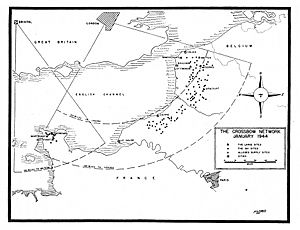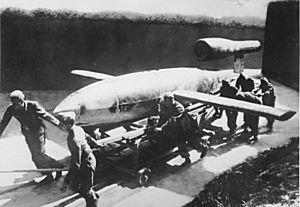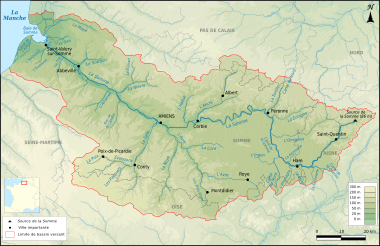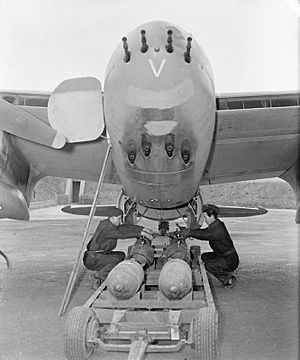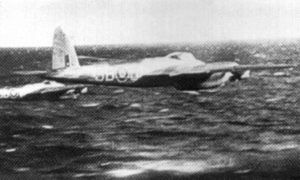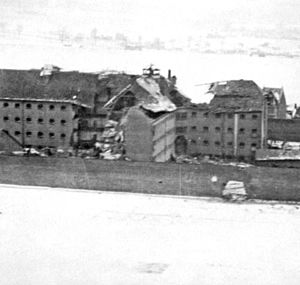Operation Jericho facts for kids
Quick facts for kids Operation Jericho |
|||||||
|---|---|---|---|---|---|---|---|
| Part of Second World War | |||||||
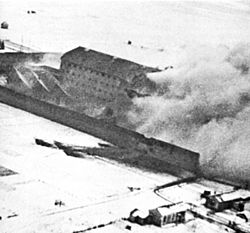 Dust and smoke from Amiens prison during the raid |
|||||||
|
|||||||
| Belligerents | |||||||
| Strength | |||||||
| 9 bombers, 12 fighters | Anti-aircraft guns 2 Fw 190 fighters |
||||||
| Casualties and losses | |||||||
| aircrew: 4 killed, 2 POW inmates: 37 killed escaping 260 reprisal killings aircraft: 2 Mosquitos 2 Typhoons |
50 killed | ||||||
Operation Jericho was a daring air raid during the Second World War. On 18 February 1944, Allied planes bombed Amiens Prison in German-controlled France. The goal was to create holes in the prison walls and free French prisoners. These prisoners were part of the French Resistance, a secret group fighting against the German occupation.
The planes, called Mosquitos, flew very low to hit the prison walls. They also aimed to destroy guard buildings. The plan was for the explosions to open cell doors without completely destroying the prison. Outside, members of the French Resistance were ready to help the prisoners escape.
Out of 832 prisoners, 258 managed to escape. This included 79 members of the Resistance. However, about two-thirds of those who escaped were later caught again. The raid was known for its incredible precision and bravery. It was even filmed by a camera on one of the Mosquito planes.
Contents
Why the Raid Happened
The French Resistance Movement
During 1943, the Allies and Germans were very interested in the Pas de Calais area of France. The Allies wanted to learn about German defenses for a future invasion. They also wanted to keep German troops busy in France. The Germans, on the other hand, wanted to keep their plans secret.
A man named Lucien Pieri in Amiens was secretly working for the German secret police, the Gestapo. He had many informers who helped him find members of the French Resistance. Because of this, many French, British, and American secret agents were caught.
In late 1943, a key Resistance leader named Roland Farjon was captured. This led to many other Resistance members being arrested. These prisoners were held in Amiens prison. In December 1943, twelve Resistance members were shot there.
On 14 February 1944, Raymond Vivant, another important Resistance leader, was arrested. Vivant knew a lot about the Allies' invasion plans. His capture put the Resistance groups in great danger.
News of Vivant's capture reached England. The British and American secret services worried that the Germans would force him to reveal important information. This could ruin the Allied invasion plans. They decided that Vivant had to be freed, or at least prevented from talking.
Amiens Prison Details
The French Resistance gathered information about Amiens prison. Maurice Holville, a Resistance member, pretended to deliver packages. This allowed him to sketch the prison's inside layout. Other members studied the outside walls. They even got blueprints of the prison from town records.
The information showed that the main prison building was shaped like a cross. It was very large and tall. The prison grounds were surrounded by an 11-foot-high wall. German guards' quarters were at the ends of the main building. The guards usually had lunch at noon. Many prisoners also ate at this time in the central hall.
The plan was to bomb the prison walls and the ends of the main building. The shock from the bombs was supposed to open cell doors. This way, prisoners could escape without the building being completely destroyed.
It was very important to try and rescue the prisoners. This would show the Resistance members that they were not forgotten. It would also help strengthen the Resistance with new escapees. The mother of two Resistance prisoners even got herself arrested. She passed on instructions for prisoners to lie down if planes appeared.
The Resistance thought there were about 700 prisoners. About 100 political prisoners were in the German section. The rest were regular criminals. Some political prisoners were mixed with criminals because of overcrowding. On 18 February, there were 832 prisoners in total. Three British, one American, and one Belgian agent were held alone. Twenty-six men and three women were scheduled to be shot the next day.
Preparing for the Attack
On the Ground
For a week before the raid, about 100 Resistance members were ready outside the prison. Sixteen prisoners inside also knew about the plan. Twelve lookouts were placed in nearby houses. Some German-speaking Resistance members dressed in German uniforms.
Around noon, many trucks and cars were in the area, some parked and some driving by. Bicycles were hidden in houses and shops. Resistance teams were hidden nearby with guns and grenades. They were ready to rush in as prisoners ran out.
Weapons and clothing were parachuted to the Resistance. They also got blank ID cards and stamps to make fake identities for the escapees. Safe houses were prepared in Amiens and other towns. A French prison guard who supported the Resistance agreed to help. A prisoner even drew a master key and made copies. This prisoner was also asked to destroy prison records before escaping.
The Air Plan
The air raid, called Operation Jericho, was given to 140 Wing of the RAF 2nd Tactical Air Force. Eighteen Mosquito bomber planes were chosen for the mission. Six were from a New Zealand squadron, six from an Australian squadron, and six from a British squadron. The British squadron was a backup. If the first attack failed, they would bomb the prison to kill the prisoners. A special Mosquito with a camera was also sent to film the raid.
The raid was planned for noon to catch the guards at lunch. The Resistance was told the plan so they could warn prisoners and prepare. Air Vice-Marshal Basil Embry wanted to lead the raid. But he was not allowed because he was busy planning the Invasion of Normandy. Group Captain Percy Pickard took command instead.
Each Mosquito squadron had an escort of Typhoon fighter planes. A model of the prison was built using photos and details from France. This helped the pilots plan their low-altitude attack. The Mosquitos carried two types of 500-pound bombs. Some were for the outer walls, and others for the inner walls. The bombs were set to explode 11 seconds after impact.
The first group of Mosquitos would attack the eastern wall at noon. The second group would attack the northern wall. Three minutes later, the Australian squadron would attack the main building. The reserve squadron would only attack if Pickard gave the signal "Red, Daddy, Red." This meant the first attack had failed.
The weather was very bad in the days before the raid, with snow and thick clouds. On 16 February, security was very tight at the air base. Everyone was told to keep the mission secret. The bad weather delayed the raid until 18 February.
Briefing the Crews
On 18 February, the weather was still bad, but they decided to go ahead. The aircrews were woken early. At 8:00 AM, they went to the briefing room. A large model of the prison was on a table. Pickard explained the unusual and risky nature of the mission.
The crews carefully studied the route and the prison model. Many had never flown in such bad weather. Pickard would fly at the back of the second wave to check the damage. He would send the signal to the reserve squadron if needed. The Typhoon fighters were briefed quickly and took off. Some Typhoon squadrons could not take off due to the terrible weather.
The Attack Begins
The Mosquitos took off one by one, disappearing into the mist and snow. The Typhoons that could take off met some Mosquitos over the English Channel. Two Mosquitos and two Typhoons had to turn back because of the bad weather.
One Mosquito had an engine fire on the way to the target. The pilot, Flight Lieutenant Hanafin, had to turn back. The remaining Mosquitos flew on. They saw German Fw 190 fighter planes at a nearby airfield.
The Typhoons that made it to Amiens flew in a defensive circle. German Fw 190s hid in the clouds, diving on the attackers and then climbing back into the clouds.
At 12:01 PM, the Mosquitos reached the prison. The first planes aimed at the eastern and northern walls. The next group of Mosquitos had to circle because they were too close behind. At 12:06 PM, two Mosquitos attacked the eastern wall again. Two other Mosquitos bombed the main building.
A bomb hit the guardhouse, killing or injuring the guards. Many prisoners were also killed or wounded, but many others were able to escape. Pickard saw prisoners running out and signaled the reserve squadron to return to base.
As the Mosquitos flew home, German Fw 190s attacked them. The Typhoon escorts fought back. One Typhoon pilot, Flying Officer J. E. Renaud, was shot down by a German Fw 190 and became a prisoner.
Another Mosquito was hit by German anti-aircraft guns. The pilot was injured, and the navigator was killed. Pickard stayed too long over the target. His Mosquito was attacked by a German Fw 190. The tail of his plane was shot off, and Pickard and his navigator were killed.
The camera Mosquito made three passes over the prison to film the damage. Its Typhoon escorts watched over it. On the way back, the Typhoons were running low on fuel.
After the Raid
On 21 February, two more Mosquitos flew over the prison to take photos. They were met by heavy German anti-aircraft fire. One Typhoon escort was hit and crashed into the sea, killing the pilot. Two other Typhoons were damaged.
What Happened Next
Out of 832 prisoners, 255 escaped. Many were shot by guards as they ran. 182 were caught again soon after. However, the Resistance prisoners who escaped were able to expose over sixty German agents. This greatly hurt the German intelligence efforts. Ordinary prisoners who were not caught were often left alone by the French police.
Pickard and Broadley were reported missing. Everyone at the air base was told to keep quiet, hoping they had survived. But soon, news arrived that Pickard was dead. It was not until September 1944 that their deaths were officially announced.
Remembering the Raid
A plaque at the prison honors those who died in the attack. There is also a memorial at Hunsdon Airfield, the Mosquito base. In 2004, for the 60th anniversary, a Spitfire plane flew over the prison. None of the surviving Mosquitos were able to fly.
Aircraft Involved
de Havilland Mosquito
| Aircraft | Pilot | Navigator | Squadron | Notes |
|---|---|---|---|---|
| EG-R (LR333) |
W/C I. S. Smith, DFC | Flt Lt P. E. Barns, DFC | 487 RNZAF | Returned |
| EG-H (HX856) |
FS S. Jennings | WO J. M. Nichols | 487 | Returned |
| EG-T (HX982) |
Plt Offr Maxwell Sparks RNZAF |
Plt Offr A. C. Dunlop | 487 | Hit by FlaK; wheel collapsed on landing at base |
| EG-C (HX909) |
Plt Offr M. L. S. Darrall RNZAF |
Plt Offr F. S. Stevenson RNZAF |
487 | Returned |
| EG-J (HX974) |
P/O D. R. Fowler | W/O F. A. Wilkins | 487 | Returned |
| EG-Q (HX855) |
F/Lt B. D. Hanafin | P/O C. F. Redgrave | 487 | Turned back |
| SB-F (LR334) |
Wg Cdr Robert Iredale RAAF |
Flt Lt J. L. McCaul | 464 RAAF | Landed 13:00 |
| SB-A (MM402) |
Sqn Ldr W. R. C. Sugden | Fg Offr A. N. Bridges | 464 | Landed 13:00 |
| SB-U (MM410) |
F/O K. L. Monaghan | F/O A. W. Dean | 464 | Landed 12:50 |
| SB-V (MM403) |
F/Lt T. McPhee RNZAF |
F/Lt G. W. Atkins | 464 | Landed 12:50 |
| SB-T (MM404) |
S/Ldr A. I. McRitchie RNZAF | F/Lt R. Sampson RNZAF |
464 | Shot down by FlaK near Amiens; pilot POW, navigator killed. |
| EG-F (HX922) |
Gp Capt Percy Pickard | Flt Lt John Broadley | 464 RAAF (aircraft from 487 Sqn) |
Shot down by Wilhelm Mayer; buried at Amiens |
| O-Orange (DZ414) |
Flt Lt A. Wickam | P/O L. Howard | FPU | Returned |
| YH-U (LR403) |
Wg Cdr I. G. Dale | F/O E. Gabites | 21 RAF | Called off |
| YH-J (MM398) |
F/Lt M. J. Benn | F/O N. A. Roe | 21 | Called off |
| YH-C (HX930) |
F/Lt A. E. C. Wheeler | F/O N. M. Redington | 21 | Called off |
| YH-D (LR385) |
F/Lt D. A. Taylor | S/Ldr P. Livry | 21 | Called off |
| YH-P (LR348) |
F/Lt E. E. Hogan | F/Sgt D. A. S. Crowfoot | 21 | Turned back |
| YH-F (LR388) |
F/Sgt A. Steadman | P/O E. J. Reynolds | 21 | Turned back |
Hawker Typhoons
| Aircraft | Pilot | Sqn | Notes |
|---|---|---|---|
| JR133 | F/O J. E. Reynaud | 174 RAF | Shot down by Fw 190 north of Amiens, taken prisoner |
| JP793 | F/Sgt H. S. Brown | 174 | Last seen entering a snowstorm 20 nmi (37 km; 23 mi) SSE of Beachy Head |
| JR310 | F/Lt F. A. Grantham | 174 | Landed 12:50 |
| JP541 | F/Sgt F. E. Wheeler | 174 | Landed 12:50 |
| JP671 | F/Lt G. I. Mallett | 174 | Landed 12:50 |
| JP308 | F/O W. C. Vatcher | 174 | Landed 12:50 |
| JR303 | P/O W. D. Burton | 174 | Landed 12:50 |
| XP-A (JP535) | F/O H. V. Markby | 174 | Landed 12:50 |
| F/Lt R. Dall | 198 RAF | Bad weather at RAF Manston; landed at RAF Tangmere at 12:50 | |
| F/Lt J. Scambler | 198 | Bad weather at Manston; landed Tangmere 12:50 | |
| F/Lt R. Roper | 198 | Bad weather at Manston; landed Tangmere 12:50 | |
| F/O R. Armstrong | 198 | Separated from main formation in snowstorm; landed at base, 11:30 | |
| F/Lt Raymond Lallemant | 198 | Separated from main formation in snowstorm; landed at base, 11:15 | |
| F/Lt J. Niblett | 198 | Separated from main formation in snowstorm; landed at base, 11:15 |
See also
- Aarhus Air Raid, attack on Gestapo headquarters in Aarhus, Denmark
- Operation Carthage, attack on Gestapo headquarters in Copenhagen, Denmark
- Oslo Mosquito raid, attack on Gestapo headquarters in Oslo, Norway


